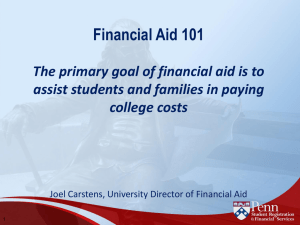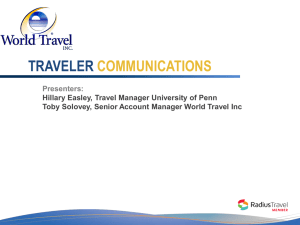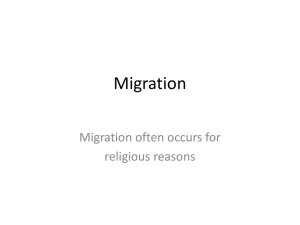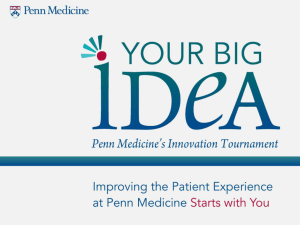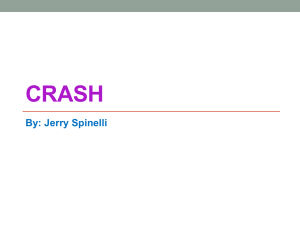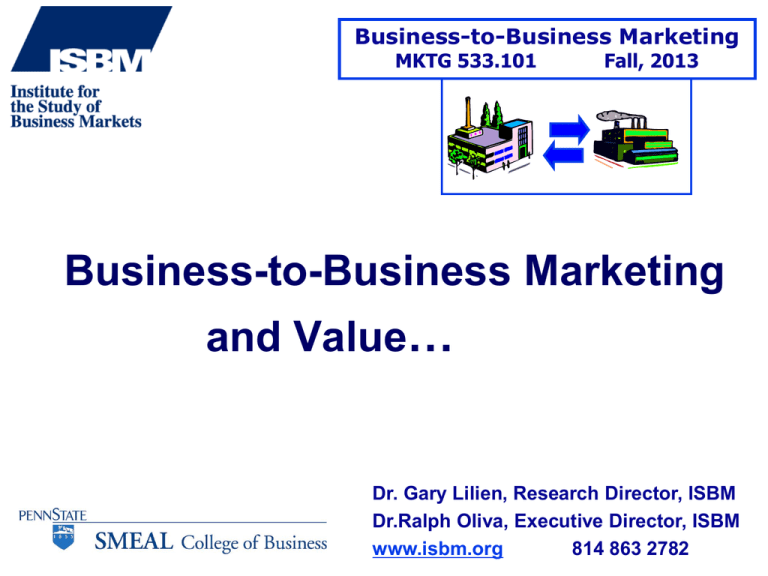
Business-to-Business Marketing
MKTG 533.101
Fall, 2013
Business-to-Business Marketing
and Value…
Dr. Gary Lilien, Research Director, ISBM
Dr.Ralph Oliva, Executive Director, ISBM
www.isbm.org
814 863 2782
Marketing “Value - Delivery Framework”
1. Build Value Understanding
2. Strategy Formulation
3. Design Customer Value
4. Communicate and Deliver Value
5. Life-Cycle Management
TM
22
(c) 2013, ISBM - Penn State
4/13/2015
1. Build Value Understanding
Understand the language and concept of Value*
Study and understand the key environmental Trends
with impact on your marketing efforts
Understand value and processes in:
Customers
Competitors
"Trends and
4C's Analysis"
Category
Value Chain
TM
3
(C) 2013, ISBM - Penn State
1. Build Value Understanding
2. Strategy Formulation
Segmentation
Targeting
Positioning
Synthesis of Segment Strategies
Our Primary
Concentration in this
course
TM
4
(C) 2013, ISBM - Penn State
Conceptualize Market Structure for STP
Think of Markets as Hierarchies of Customers
Mass Market Non-Segmentation
After studying segmentation of
market decide to treat every
customer the same
"Spray and Pray"
Customer Categorization
Classify customers into logical
categories then target and allocate
resources – geography, product
usage, customer size
Segments
Classify customers by their needs,
problems, attitudes, and behaviors
then select targets and allocate
resources
Segments of One
Customize offering to each customer
– costly, but ultimate marketing!
Thanks to: Dr. Bob Thomas, Georgetown
6/13/11
5
1. Build Value Understanding
2. Strategy Formulation
3. Design Customer Value
New Product/Portfolio
Management Processes
Value and Pricing Strategy*
Brand Strategy and Management
TM
6
(C) 2013, ISBM - Penn State
1. Build Value Understanding
3. Design Customer Value
2. Strategy Formulation
4. Communicate and Deliver Value
Integrated Market Communications
Channel/Distribution Strategy
Sales Management/Support*
TM
7
(C) 2013, ISBM - Penn State
1. Build Value Understanding
3. Design Customer Value
2. Strategy Formulation
4. Communicate and Deliver Value
5. Life-Cycle Management
Manage Customer Relationships
Measure/Track Performance
Process Management/Continuous
Improvement
Education/Professional Development
TM
8
(C) 2013, ISBM - Penn State
Pricing a New Product…
…Kalrez® resists over 1,800 different chemicals while offering the high temperature
stability of PTFE (327°C). Kalrez® parts provide reliable, long-term service with a wide
range of aggressive industrial and electronic grade chemicals. It is used in highly
aggressive chemical processing, semiconductor wafer processing, pharmaceutical, oil
and gas recovery, aerospace and petroleum applications
TM
9
(c) 2013, ISBM - Penn State
Kalrez®: A replacement for
conventional Neoprene
rubber “O-Ring” Material…
Neoprene Rubber: Replace
every 3 months…
Kalrez®: Replace every
3 years…
Key Issues…
Kalrez® didn’t cost much more to manufacture than
the incumbent O-Ring material Neoprene rubber (?)
The cost of O-Ring replacement:
O-rings Themselves
Process Shutdown
Special Labor
Disassembly/worker protection
Reassembly
Process Startup
Lost production
What else?
3x/yr
1/3x /yr
TM
What is the “value” of Kalrez®?
(c) 2013, ISBM - Penn State
11
Value, Costs and Prices…
Price
Margin
Total
Cost
External
Purchases
TM
12
12
(c) 2013, ISBM - Penn State
4/13/2015
COST-BASED PRICING
Traditional Costing
Activity-Based Costing
Direct Costs
Indirect costs
assigned to activities
Indirect cost
allocations
(indexed)
Allocated by activity
usage
Price = Costs + Margin Target
TM
13
13
(c) 2013, ISBM - Penn State
4/13/2015
What’s the biggest problem
with cost-based pricing?
TM
14
14
(c) 2013, ISBM - Penn State
4/13/2015
CONCEPTUALIZE
EXERCISE
What should the term, “customer value”
mean when applied to a product or service?
15
© 2010, ISBM _ Penn State
Customer Value Definition
Customer Value is the economic impact,
compared to the next best alternative, a supplier’s
offering has on a customer’s business. Economic
impact comes from increasing a customer’s
revenue flow and/or decreasing a customer’s cost
of operations.
Offering: Tangible Product/Service, Brand,
Relationships, KnowHow, Everything…
TM
16
6/13/11
(c) 2013, ISBM - Penn State
16
Customer Perceived Value Definition
A customer’s current understanding of an
offering’s economic impact on their business.
Perceived value may be less than customer
value because:
• Customers may not be aware of a supplier’s
total value delivery.
• Customers may take a lower value position
for price negotiations.
TM
(c) 2013, ISBM - Penn State
Conceptualizing: Value, Costs, and Prices
Customer
Value
Perceived
Value
Total
Cost
External
Purchases
18
© 2001, ISBM _ Penn State
BUYER-SELLER RELATIONSHIPS
• Positive sum game (win-win) -- Cooperation
• You, customers, your supply chain, etc. -work together to create value...
• “Essence” of growth of the GDP...
19
© 2010, ISBM _ Penn State
Conceptualizing: Value, Costs, and Prices
Customer
Value
Perceived
Value
Value Created
Total
Cost
External
Purchases
20
© 2010, ISBM _ Penn State
Price: The “Knife” That Distributes Value
Customer
Value
Perceived
Value
Price
Value Created
Total
Cost
External
Purchases
21
© 2010, ISBM _ Penn State
The “Zero-Sum” Game: Pricing
VALUE CREATED - The Value “Salami”
“Cut” by price into two pieces:
Margin (x Quantity) - the seller’s economic
driving force
Value distributed (x Quantity) - the customer’s
economic driving force
22
© 2010, ISBM _ Penn State
Buyer-Seller Relationships: The Two Games
Positive sum game (win-win) -Cooperation
Zero sum game (win-lose) -Competition
Implications for “Customer Satisfaction”
Creating Value Together:
"Positive Sum"
Dividing the Value:
"Zero Sum"
23
Conceptualizing Value: Language and Taxonomy
Value, Costs, and Prices
Customer
Value
Differentiation
Value
Perceived
Value
Incentive
To Buy
Price
Price
Total
Cost
External
Purchases
Competitive
Reference
Value
Incentive
To Supply
KNOWING COSTS AND VALUES
Customers spend more effort to know
supplier’s costs
than
Suppliers spend to know customer’s values
POWER vs. “PARTNERSHIP”
TM
25
25
(c) 2013, ISBM - Penn State
4/13/2015
Tools from George Cressman – Strategic Pricing Group:
EVE® Value Analysis Template
•Competitive Alternative:
•Value
•Feature •Benefit
Driver
•Positive Differential Value
•Value
Formula
•Inputs and
Sources
•Differential
Value
•Negative Differential Value
TM
•Total Differential Value
© 2009, Strategic Pricing Group: George Cressman
(c) 2013, ISBM - Penn State
26
EVE EG
26
Quantifying Value
Additional Value the
New Offering Provides
•
•
•
•
•
Reduced disposable use
Time savings
Increased success rate
Reduced recovery time
Consulting services
Positive
Differentiation
Value
Negative
Differentiation
Value
Additional Cost
Associated With
Using
the New Offering
• Technical training
• Switching costs
• Risk
Net Differentiation Value
The Value of Existing
Alternatives
•
•
•
•
•
Next best alternative
Current systems
Installed technology
Emerging competitors
Alternative solutions
Competitive
Reference Value
© 2009, Strategic Pricing Group: George Cressman
Net
Economic
Value
Streamax
Video
27
Pricing a New Product: RapidForm…
New metal treatment technology for
reducing scrap in customers
application – “RapidForm” Steel
Customer Complaints -Incumbent –Standard High-Carbon Steel :
• Extraordinarily High Scrap Rate
• Ran Slowly through Process
TM
28
28
(c) 2013, ISBM - Penn State
4/13/2015
RapidForm Pricing
• It cost very little more to make
RapidForm
• And High Carbon currently sells
for $0.60/lb
• Let’s try $0.70/lb
• They’ll buy at $0.68/lb
• We’ll make a bundle…
TM
29
29
(c) 2013, ISBM - Penn State
4/13/2015
RapidForm Value: Key Facts…
2 lbs of steel per part
Current scrap rate –very high – say 25%
Currently allotted $0.80 of machine time
to process – too slow
Specific muffler line, specific type of steel
delivered --Focused
customer application
TM
30
30
(c) 2013, ISBM - Penn State
Case Calculations…
Customer Value is the economic impact, compared to the
next best alternative a supplier’s offering has on a
customer’s business.
Value comes from two components:
• Reduced scrap generation
• Reduced Labor Cost
Are there any other value elements?
TM
(c) 2013, ISBM - Penn State
Tools from George Cressman – Strategic Pricing Group:
EVE® Value Analysis Template
•Competitive Alternative:
•Value
•Feature •Benefit
Driver
•Positive Differential Value
RapidForm
Easier
Stamping
than HC
RapidForm
Easier
Stamping
than HC
•Value
Formula
•Inputs and
Sources
Customer
2
lbs/part
X
Reduced
Less
Factory
$0.60/lb
X
Scrap Rate
Waste
Floor
(.25 - .05)
Reports
Customer
$0.80
$0.50
Fewer
Reduced
= $0.30 Labor Factory
Sheets
fed
to
Scrap Rate
Savings/part Floor
Machine
Reports
•Differential
Value
Savings of
$0.24/part;
$0.12/lb
Savings of
$0.30/part;
$0.15/lb
•Negative Differential Value
TM
•Total Differential Value
32
© 2009, Strategic Pricing Group: George Cressman
(c) 2013, ISBM - Penn State
EVE EG
32
Decreased
Labor $0.15
Reduced
Scrap $0.12
Reference
Value
Next Best
Alternative
HC Steel
$0.60
Positive
Differentiation
Value
Decreased
Labor $0.15
Price Set At
$0.68/Pound
Reference
Value
Reduced
Scrap $0.12
Next Best
Alternative
HC Steel
$0.60
Total Value
Delivery =
$0.82/lb
Could the price have
been set higher?
If so, how could the
firm achieve a higher
price?
A very important – and often
unasked – question…
WHY does my customer buy my
product/service?
And others…
WHAT is it’s REAL value?
WHO is the key decider?
Do we really know?
TM
(c) 2013, ISBM - Penn State
Tools to Build Value Understanding
ALCOA’S PROBING CHECKLIST
I would like to learn more about how you’re using my product:
• Inventory
• Added Operations
• Rejects
• Inspections
• Any Added Parts
• Waste
• Set-Up
• Special Tools
• Rework
• Delays
For each of the above:
• Can I see what you’re doing?
• How much time does it take?
• Why does this take place?
• How costly is it?
• What becomes of this work?
• Is there a better way?
In general:
• Get on the plant floor
• Learn all you can
• Examine the total use pattern
• Funnel information to the right people
4/13/2015
The “Next Best Alternative”
Competitive alternative should answer the question:
– What would customers do / use if they did not have our product / service?
Options for Competitive
Alternatives
1:1 Competitive Products
Where to Use?
Examples
Mature industries
Significant competition
“Near” commodities
“Spec” products
“Home grown solutions”
Technology / IT infrastructure
Making / Doing it
Themselves (Internal
Resources)
Doing Without
Combination of Products
and Services
Reference for new products / product
segments
Service driven environments
Significant support
Environments requiring integration
Chemicals
Medical Products
Printing Services
Outsourcing Services
Marketing Services
Trade Clearing Software
Online Training
Financial Services Outsourcing
Funeral Services
© 2011 George Cressman, World Class Pricing, All Rights Reserved
CONCEPTUALIZE
Build Value
Costs, Prices and Values
$0.92
Value
passed to
your
customer’s
value chain
Customer
Value
Perceived
Value
Compute and
Explain Value
Move Perceived
toward
Customer Value
Price to Harvest
Value
Total
Cost
Manage Over the
Life Cycle
External
Purchases
38
© 2010, ISBM _ Penn State
Demonstrate, Document
Demonstrate value – build the
value in use and “resonating
focus” value proposition before
the sale
Document value – after the sale –
product in use: create the
scenario for documenting that the
value promised was delivered.
TM
39
39
(c) 2013, ISBM - Penn State
Next…
Building a Customer Value Model
Account Pricing for the Abcor 2000
Pricing Options for Atlantic Computer
TM
40
40
(c) 2013, ISBM - Penn State
4/13/2015
Application: Account Pricing for Abcor 2000
Focus ONLY on the Longform
Printing Account:
Prepare a bid
Justify that bid both to Longform and to
your (Abcor) managment
Other Q’s…
How much info about buyer’s costs should
buyer reveal?
How much pricing authority should a
salesperson have?
TM
Due at 6 PM Tuesday, Sept 3
(c) 2013, ISBM - Penn State
4/13/2015
41
41
Break Even VIU for Abcor 2000
Assumptions: (0% discount rate, for simplicity)
Costs:
Machine Cost = $3980
Plate Cost = $2.00 ea.
Assume Usage:
1000 plates/year – 8 years=8000 plates
Break-Even:
0= MachPrice-3980+8000*(PlatePrice-2.00)
Seller Break Even Chart:
Machine Price vs. Price/Plate
Sell Here
The Buyer’s Side
Additional Buyer Assumptions: :
Salvage Value Old Machine/ New Machine: $1000/$3000
Old Plate Price = $5.00 ea.
Break-Even:
0= $1000+$3000-MachPrice +8000*($5.00-PlatePrice)
Buyer Break Even Chart:
Machine Price vs. Price/Plate
Buy Here
Combining The Two..
Zone of Agreement




